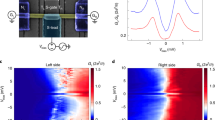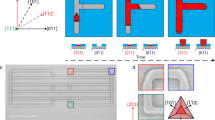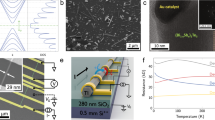Abstract
Signatures of Majorana fermions have recently been reported from measurements on hybrid superconductor–semiconductor nanowire devices. Majorana fermions are predicted to obey special quantum statistics, known as non-Abelian statistics. To probe this requires an exchange operation, in which two Majorana fermions are moved around one another, which requires at least a simple network of nanowires. Here, we report on the synthesis and electrical characterization of crosses of InSb nanowires. The InSb wires grow horizontally on flexible vertical stems, allowing nearby wires to meet and merge. In this way, near-planar single-crystalline nanocrosses are created, which can be measured by four electrical contacts. Our transport measurements show that the favourable properties of the InSb nanowire devices—high carrier mobility and the ability to induce superconductivity—are preserved in the cross devices. Our nanocrosses thus represent a promising system for the exchange of Majorana fermions.
This is a preview of subscription content, access via your institution
Access options
Subscribe to this journal
Receive 12 print issues and online access
$259.00 per year
only $21.58 per issue
Buy this article
- Purchase on Springer Link
- Instant access to full article PDF
Prices may be subject to local taxes which are calculated during checkout






Similar content being viewed by others
References
Majorana, E. A symmetric theory of electrons and positions. Soryushiron Kenkyu (Engl. Transl.) 63, 149 (1981) [translation from Teoria simmetrica dell'electtone e del positrone. Nuovo Cimento 14, 171 (1937)].
Mourik, V. et al. Signatures of Majorana fermions in hybrid superconductor–semiconductor nanowire devices. Science 336, 1003–1007 (2012).
Das, A. et al. Zero-bias peaks and splitting in an Al–InAs nanowire topological superconductor as a signature of Majorana fermions. Nature Phys. 8, 887–895 (2012).
Deng, M. T. et al. Anomalous zero-bias conductance peak in a Nb–InSb nanowire–Nb hybrid device. Nano Lett. 12, 6414–6419 (2012).
Freedman, M. H., Kitaev, A., Larsen, M. J. & Wang, Z. Topological quantum computation. Bull. Am. Math. Soc. 40, 31–38 (2003).
Nayak, C., Simon, S. H., Stern, A., Freedman, M. & Das Sarma, S. Non-Abelian anyons and topological quantum computation. Rev. Mod. Phys. 80, 1083–1159 (2008).
Kitaev, A. Fault-tolerant quantum computation by anyons. Ann. Phys. 303, 2–30 (2003).
Wilczek, F. Majorana returns. Nature Phys. 5, 614–618 (2009).
Lutchyn, R. M., Sau, J. D. & Das Sarma, S. Majorana fermions and a topological phase transition in semiconductor–superconductor heterostructures. Phys. Rev. Lett. 105, 077001 (2010).
Oreg, Y., Refael, G. & von Oppen, F. Helical liquids and Majorana bound states in quantum wires. Phys. Rev. Lett. 105, 177002 (2010).
Alicea, J., Oreg, Y., Refael, G., von Oppen, F. & Fisher, M. P. A. Non-abelian statistics and topological quantum information processing in 1D wire networks. Nature Phys. 7, 412–417 (2011).
van Heck, B., Akhmerov, A. R., Hassler, F., Burrello, M. & Beenakker, C. W. J. Coulomb-assisted braiding of Majorana fermions in a Josephson junction array. New J. Phys. 14, 035019 (2012).
Hyart, T. et al. Flux-controlled quantum computation with Majorana fermions. Phys. Rev. B 88, 035121 (2013).
Algra, R. E. et al. Twinning superlattices in indium phosphide nanowires. Nature 456, 369–372 (2008).
Wen, C-Y. et al. Periodically changing morphology of the growth interface in Si, Ge, and GaP Nanowires. Phys. Rev. Lett. 107, 025503 (2011).
Glas, F., Harmand, J-C. & Patriarche, G. Why does wurtzite form in nanowires of III–V zinc blende semiconductors? Phys. Rev. Lett. 99, 146101 (2007).
Dick, K. A. et al. Synthesis of branched ‘nanotrees' by controlled seeding of multiple branching events. Nature Mater. 3, 380–384 (2004).
Yun, S. H., Wu, J. Z. Dibos, A., Zou, X. & Karlsson, U. O. Self-assembled boron nanowire Y-junctions. Nano Lett. 6, 385–389 (2006).
Jiang, X. et al. Rational growth of branched nanowire heterostructures with synthetically encoded properties and function. Proc. Natl Acad. Sci. USA 108, 12212–12216 (2011).
Manna, L., Milliron, D. J., Meisel, A., Scher, E. C. & Alivisatos, A. P. Controlled growth of tetrapod-branched inorganic nanocrystals. Nature Mater. 2, 382–385 (2003).
Dai, X. et al. Tailoring the vapor–liquid–solid growth toward the self-assembly of GaAs nanowire junctions. Nano Lett. 11, 4947–4952 (2011).
Suyatin, D. B. et al. Electrical properties of self-assembled branched InAs nanowire junctions. Nano Lett. 8, 1100–1104 (2008).
Dalacu, D., Kam, A., Austing, D. G. & Poole, P. J. Droplet dynamics in controlled InAs nanowire interconnections. Nano Lett. 13, 2676–2681 (2013).
Wagner, R. S. & Ellis, W. C. Vapor–liquid–solid mechanism of single crystal growth. Appl. Phys. Lett. 4, 89–90 (1964).
Plissard, S. R. et al. From InSb nanowires to nanocubes: looking for the sweet spot. Nano Lett. 12, 1794–1798 (2012).
Van Weperen, I. et al. Quantized conductance in an InSb nanowire. Nano Lett. 13, 387–391 (2013).
Li, D. et al. Direction-specific interactions control crystal growth by oriented attachment. Science 336, 1014–1018 (2012).
Doh, Y-J. et al. Tunable supercurrent through semiconductor nanowires. Science 309, 272–275 (2005).
Xiang, J. et al. Ge/Si nanowire mesoscopic Josephson junctions. Nature Nanotech. 1, 208–213 (2006).
Borgström, M. T. et al. In situ etching for total control over axial and radial nanowire growth. Nano Res. 3, 264–270 (2010).
Kautz, R. L. & Martinis, J. M. Noise affected I–V curves in small hysteretic Josephson junctions. Phys. Rev. B 42, 9903–9937 (1990).
Courtois, H. et al. Origin of hysteresis in a proximity Josephson junction. Phys. Rev. Lett. 101, 067002 (2008).
Fiske, M. D. Temperature and magnetic field dependences of Josephson tunneling current. Rev. Mod. Phys. 36, 221–222 (1964).
Coon, D. D. & Fiske, M. D. Josephson AC and step structure in supercurrent tunneling characteristic. Phys. Rev. 138, A744–A746 (1965).
Acknowledgements
This work was supported by the Dutch Organization for Scientific Research (NWO), the Foundation for Fundamental Research on Matter (FOM) and Microsoft Corporation Station Q. D.C. and A.G. acknowledge financial support from the European Union Seventh Framework Programme (grant agreement no. 265073, NANOWIRING).
Author information
Authors and Affiliations
Contributions
S.R.P. and E.P.A.M.B. supervised the experiments. G.W.G.I., S.R.P., D.C. and E.P.A.M.B. grew the T- and X-shaped nanowires. S.R.P. performed the XRD measurements. M.V. analysed the structures using TEM. I.v.W., J.K., L.J.C. and D.B.S. fabricated the cross devices and performed the electrical measurements. I.v.W., J.K., L.J.C., D.B.S., A.G., S.M.F. and L.P.K analysed the electrical data. The manuscript was prepared with contributions from all authors.
Corresponding authors
Ethics declarations
Competing interests
The authors declare no competing financial interests.
Supplementary information
Supplementary information
Supplementary Information (PDF 10087 kb)
Rights and permissions
About this article
Cite this article
Plissard, S., van Weperen, I., Car, D. et al. Formation and electronic properties of InSb nanocrosses. Nature Nanotech 8, 859–864 (2013). https://doi.org/10.1038/nnano.2013.198
Received:
Accepted:
Published:
Issue Date:
DOI: https://doi.org/10.1038/nnano.2013.198



